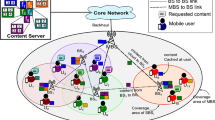Abstract
In most wireless networks, users/peers are connected to backbone networks using access links. The access link capacity is divided into upload and download capacity, and these capacities are used for upload and download of data, respectively. A peer can modify this division of link capacity between upload and download. A peer will allocate its entire link capacity for download to maximize utility. But incentive mechanism forces them to allocate some portion of capacity for upload. This paper investigates how to optimally divide link capacity so that peers receive maximum utility in a P2P network. We model this scenario as a game and determine capacity partitioning of peers during the Nash equilibrium NE. We also prove the social optimality of NE. As this portioning maximizes individual as well as social benefit, so NE is an optimal state of capacity partition. Using simulation, we verify that NE is an optimal state. BitTorrent network and a distributed algorithm for dividing access capacities are simulated, and partition providing maximum utility is compared with NE. This work provides a generalized expression and the mathematical proof for capacity partitioning at which peers receive maximum utility.



Similar content being viewed by others
Notes
A round starts with each peer sending requests to other peers, and after that, all the serving peers allocate their resources to the requesters. A round ends after every peer has received the resources.
For partition 18-0 in Fig. 3 the incentive level of peers is zero as they allocate zero capacity for upload. But they can receive some utility/resources because of the random unchoke policy of BitTorrent.
During the first round \(\Delta =\frac{C_i}{10}\). For subsequent rounds, the size of \(\Delta \) depends on the difference in utility received in the last two rounds, such that \(\Delta \) value decreases if the difference is low; otherwise, it increases (refer [12] for details about \(\Delta \) calculation).
For some initial rounds, newcomers are provided a fixed incentive level independent of their contribution. It is assumed that newcomers have no data to share. This strategy allows them to receive resources from the network, which can be later shared with other peers [4]
References
Feldman, M., Papadimitriou, C., Chuang, J., Stoica, I.: Free-riding and whitewashing in peer-to-peer systems. IEEE J. Sel. Areas Commun. 24, 1010–1019 (2006)
Adar, E., Huberman, B.A.: Free riding on gnutella. First Monday 5, 2000 (2000)
Zhou, R., Hwang, K.: Powertrust: a robust and scalable reputation system for trusted peer-to-peer computing. IEEE Trans. Parallel Distrib. Syst. 18(4), 460–473 (2007)
Satsiou, A., Tassiulas, L.: Reputation-based resource allocation in P2P systems of rational users. IEEE Trans. Parallel Distrib. Syst. 21, 466–479 (2010)
Shin, K., Joe-Wong, C., Ha, S., Yi, Y., Rhee, I., Reeves, D.S.: T-chain: A general incentive scheme for cooperative computing. IEEE/ACM Trans. Netw. 25, 2122–2137 (2017)
Cohen, B.: “Incentives build robustness in bittorrent,” in Proceedings of the Workshop on Economics of Peer-to-Peer Systems, 5-6 (2003)
Singha, N., Singh, Y.: New incentive mechanism to enhance cooperation in wireless p2p networks. Peer-to-Peer Netw. Appl. 14, 1–11 (2021)
Meo, M., Milan, F.: “A rational model for service rate allocation in peer-to-peer networks,” in IEEE INFOCOM, pp. 1–5 (2006)
T1, A.: 413-1998, “Network and customer installation interfaces - asymmetric digital subscriber line (ADSL) metallic interface,” American National Standards Institute, (1998)
Jeong, D.G., Jeon, W.S.: CDMA/TDD system for wireless multimedia services with traffic unbalance between uplink and downlink. IEEE J. Sel. Areas Commun. 17, 939–946 (1999)
Chiang, C.H., Liao, W., Liu, T.: “Adaptive downlink/uplink bandwidth allocation in IEEE 802.16 (WiMAX) wireless networks: A cross-layer approach,” in IEEE GLOBECOM, pp. 4775–4779 (2007)
Singha, N., Singh, Y.N., Gupta, R.: Adaptive capacity partitioning in cooperative computing to maximize received resources. IEEE Access 8, 3551–3565 (2020)
B. H. et al, “Linux advanced routing and traffic control howto,” [Available Online] http://www.lartc.org/
Goswami, A., Gupta, R., Parashari, G.S.: Reputation-based resource allocation in P2P systems: a game theoretic perspective. IEEE Commun. Lett. 21, 1273–1276 (2017)
Singha, N., Singh, Y.N.: Optimal capacity partitioning in homogeneous p2p network. IEEE Commun. Lett. 22(7), 1354–1357 (2018)
Ma, J., Li, M., Li, H.-J.: Traffic dynamics on multilayer networks with different speeds. IEEE Trans. Circuits Syst. II: Exp. Briefs 69(3), 1697–1701 (2022)
Zhang, J., Ma, J., Li, H.-J.: An efficient link closing strategy for improving traffic capacity on scale-free networks. Stat. Mech. Appl. 604, 127887 (2022)
Goswami, A., Parashari, G.S., Gupta, R.: Evolutionary stability of reputation-based incentive mechanisms in p2p systems. IEEE Commun. Lett. 22(2), 268–271 (2018)
Funding
No funds, grants, or other support was received for the publication of this article. Further, authors have no competing interests to declare that are relevant to the content of this paper.
Author information
Authors and Affiliations
Contributions
Dr. Nitin and Dr. Mahesh have contributed to writing the manuscript. Dr. Nitin has also performed simulations, so he is the corresponding author.
Corresponding author
Ethics declarations
Conflict of interest
The authors declare no competing interests.
Additional information
Publisher's Note
Springer Nature remains neutral with regard to jurisdictional claims in published maps and institutional affiliations.
Rights and permissions
Springer Nature or its licensor (e.g. a society or other partner) holds exclusive rights to this article under a publishing agreement with the author(s) or other rightsholder(s); author self-archiving of the accepted manuscript version of this article is solely governed by the terms of such publishing agreement and applicable law.
About this article
Cite this article
Singha, N., Singh, M.K. Maximizing utility by optimal capacity division in P2P networks. Cluster Comput 27, 1159–1168 (2024). https://doi.org/10.1007/s10586-023-03996-x
Received:
Revised:
Accepted:
Published:
Issue Date:
DOI: https://doi.org/10.1007/s10586-023-03996-x




